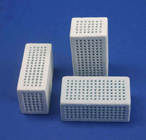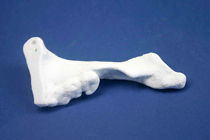Ceramic materials and their composition
Components made of ceramic materials can be produced by all common additive processes, even from dense and porous ceramics, as current R&D projects show. With the exception of selective laser sintering, additive manufacturing is followed by a conventional thermal process for debinding and sintering. The additive manufacturing of ceramics serves particularly for the production of functional components in form of prototypes, small series or individual construction units. In comparison to polymers and metals, the production of ceramics is more challenging with respect to material and technology. The choice of materials depends on the respective requirements of the desired application: In addition to oxide ceramics (e.g. Al2O3, ZrO2), nitrides (e.g. Si3N4, AlN), carbides (e.g. SiC, TiC), silicate ceramic components (e.g. cordierite, porcelain) or bioactive ceramics (Ca-phosphates) as well as ceramic components can be produced by additive manufacturing from composite materials or with a graded material structure.

